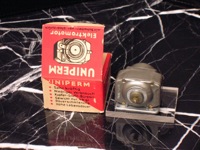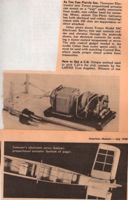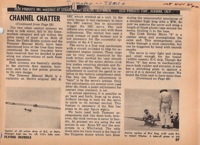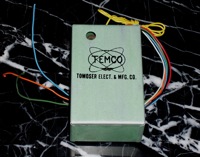Special Exhibit:
TEMCO One
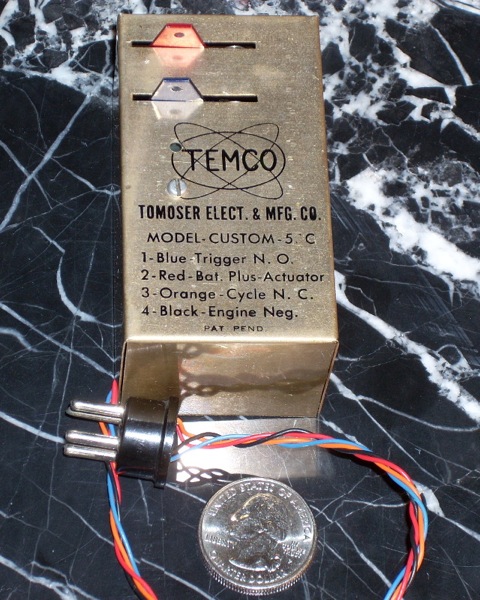
(Click on any of the images on this page to see a larger version)
This was Herb Tomoser’s personal TEMCO 5SC. Herb owned TEMCO, which stood for Tomoser Electronics and Manufacturing Company. The TEMCO 5SC was a wonder to behold when it came out in early 1958. This little “magic box” could somehow deliver right and left rudder, up and down elevator and even engine control, all from a single channel transmitter. When RC guru Ed Lorenz reviewed the 5SC in April 1958 he saved it until the end of a long list of new products and then began… “Now for the desert, pie’ce de resistance…” From a guy like Lorenz, this was quite a compliment.
But even Ed Lorenz didn’t know that Herb Tomoser might have secretly been the largest servo manufacturer in the United States. Tomoser preferred to stay anonymous, his company little known. He secured a niche in radio control history by manufacturing servos, first for others, then under his own brand name. His TEMCO 5SC was particularly popular, selling out quickly. In the end, this was the only magic box he had left.
Temco One.
As a boy Tom Tomoser was always prepared when his friends boasted about their dads: “Yeah, well my dad has an I.Q. of 235, which puts him in the genius category”. Herb Tomoser certainly made ingenious radio control equipment. In the 1920’s, he and a Buffalo, NY buddy enjoyed hand launched gliders, free flight, control-line – anything that could fly. By 1950 they moved up to radio control and his buddy started manufacturing RC equipment under the name DMECO. That stood for DeBolt Model Engineering Company. His pal was Hal DeBolt.
Around 1951, Herb Tomoser and Hal DeBolt struck a deal for Herb to manufacture all DeBolt servos. DeBolt’s servos were widely advertised and sold in very large numbers. We are not aware of any servo manufacturer who surpassed DeBolt’s volume in the early years. Since the servos were actually made by TEMCO, Herb Tomoser may have been the largest servo manufacturer in the US, or even in the world, for a while.
DeBolt was reluctant to redesign his established, successful servo line, so Tomoser decided to design his own actuators. He devised a unique servo which could enable single channel transmitters to deliver five separate positions. He named it accordingly, the “5SC”. He demonstrated one for DeBolt and asked if he wanted to add these to his DMECO line. DeBolt declined, but said they were different enough from DMECO products that Herb would have his blessing if he wanted to produce and sell them under his own name.
That’s when TEMCO emerged from the shadows and began to make a name for itself. Herb moved production from his basement to a 500 square foot shop in downtown Buffalo. For a time he continued to make DMECO servos alongside his new TEMCO actuators (the latter in much smaller numbers).
The 5SCs were sold together with a special 5-button control box to perform their 5-position magic. These boxes plugged into any single channel transmitter and eliminated the need to furiously pulse or key into the transmitter the requisite number of signals. This was done automatically by the control box. See Prototype TEMCO.
Here is the first national ad for the 5SC (April 58’ MAN):
One of the most attractive features of the 5SC was that it was entirely self-contained, except for motor control which required a separate escapement wired to the 5SC’s fifth position switch. Rudder and elevator were operated via push rods like modern servos. Control movement was not proportional, of course. On fresh batteries (4 ½ volts) response time for a complete cycle was less than 0.8 seconds. Lorenz remarked that “many unusual control combinations may be obtained that generally are not obtainable with other motor driven actuators, including climbing turns, engine control in recovering from a loop and many others” (April 58’ AM).
Lorenz also commented that the actuator used no current except when actually moving from position to position and was “beautifully built using top quality parts and materials throughout”. He thought it light enough to be used in small “1/2 A” size planes and likely to be most attractive to those wanting to move from rudder-only to multi-channel type flying at minimum expense. Flyers could still use their existing single channel transmitter and receiver and pay only $49.95 for the TEMCO 5SC and pulser box to step up to multi.
Here is the new product review on the 5SC from American Modeler (July 58’ AM):
In late 1959, TEMCO introduced their “Ultra-mediate” version of the 5SC. We are uncertain what changes were incorporated but it was said to be able to operate from normal single button, single channel transmitters by manual blipping. This enabled it to be sold alone, without the control box, and at a price reduced to $16.95. Here is the new product announcement (Dec 59’ FM):
In mid-1961 the system was reviewed again, this time with the designation 5C. It continued to be manually operable but now was offered with a joystick control box instead of the old push button model. Here’s the review (Oct/Nov 61’ FM). Note that the author prefers the stick controller and is pleased by the unit’s ability to go left and right or up and down, without having to cycle to neutral:
Here are pictures from that review. Note how the pulser box is plugged into a standard CG (F&M) “Venus” transmitter and how the cover of the “5C” was obviously a “5SC” cover with the “S” scratched (mostly) out. Our TEMCO One unit is the same. At this time we are uncertain what the exact electronic and mechanical differences are between the 5SC and the 5C. Ours may, in fact, be the latter, or the former, or both. Research continues.
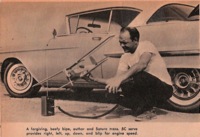 | 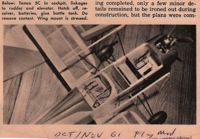 |
Here is a 1961 article picturing a 5C installed with a TEMCO receiver (Jun/Jul 61’ FM):
TEMCO announced that it would be introducing transmitters as well but, based on research to date, it appears they never did. TEMCO did make receivers, however, clad in the green colored cases which would become familiar on TEMCO’s more advanced servo lines introduced in 1963. Here’s an actual TEMCO receiver, from our museum.



